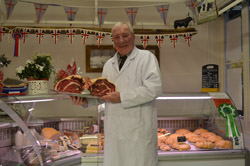
Christmas dinner has evolved over the centuries. In the Middle Ages the rich would most likely be tucking into boar’s head while the poor would be grateful for a pie made from leftovers. Fast-forward to the Victorian era, and goose was the meat of the moment. It was not until the mid-19th century that turkey headed the pecking order as the traditional centrepiece of the festive table and the UK now consumes some 10 million of them at Christmas.
When it comes to choosing meat for the most important lunch of the year, a good butcher is your fairy godmother or, in most cases, godfather, dressed in snowy white overalls and carrying a glistening meat cleaver in place of a wand. Someone like William Walton (pictured), full of friendly advice, who immediately fills you with self-belief that whatever you cook, it’s going to be a dazzling success. William – the fourth generation of his family to become a butcher - runs the Outwood Butchers Shop, hidden away in the village of Outwood, a few miles from Crawley.
For customers treading the traditional turkey route, he sources free-range birds from John Howe, a farmer in Kent. Let’s face it; for feeding a crowd, it’s hard to beat turkey – even a smaller specimen weighing five kilos (11lb) will provide plenty of meat for a dozen or more people. William says being fed a natural diet and allowed to roam the fields is important for the birds’ well-being and, in turn, flavour.
Another advocate of impeccably reared turkeys is Hazel Cox, who is based at Moat Farm, Hookwood (also known as Simon's Free Range Eggs). Hazel, who supplies KellyBronze free-range turkeys, says, “They are slow-grown for six to seven months which results in around 50 per cent more breast meat than a fast-reared turkey and the tenderness is supreme.”
If the idea of roast beef has you all a-twinkle, consider pushing the boat out with a fore-rib, which William Walton describes as “the crème de la crème.” The beef sold at his shop comes from pedigree Sussex cattle grazed on the Titsey Estate near Oxted. It’s not cheap, but a piece with five rib bones (the largest) will serve up to 25 people. Wreathed in Yorkshire puddings, it looks amazing and, with William’s advice, cooking it will be a doddle.
At the other end of the spectrum, if you’re dreaming of a cosy Christmas for two and want to rustle up the festive roast in minutes, it’s worth bearing in mind that a partridge is not merely a mythical bird sitting in a pear tree – but a tasty option for lunch. “You don’t spend a lot of time in the kitchen with a partridge,” points out William. In fact, you can cook a whole bird in around 30 minutes, but allow at least one each or you’ll be filling up on chocolates and nuts all afternoon. Or how about pheasant? William will sell you a brace – a cock bird and a hen – which is enough for three. Pheasants cook in around 45 minutes, as do mallard ducks.
Venison is a strong contender for the Christmas table – lean, versatile and quick to cook. Ken Bashford, who owns Bashford Family Butchers in Sanderstead, Coulsdon, Caterham and Warlingham, sources his from historic Knole Park at Sevenoaks. Ken says, “Saddle is the best, it’s very tender, and you can buy it on or off the bone. I’d roll it in beef fat before roasting.” If saddle - also known as loin - is the top choice, haunch (hind leg) comes in a close second. “Haunch is the main roasting joint and can also be diced for casseroles,” explains Ken. For Christmas lunch on a budget, he suggests rolled, stuffed turkey breast or maybe pork – choose loin and ask your butcher to score it for the best crackling.
Another butcher brimming with knowledge and bonhomie is Martin Bevis of Allan Martin in Ashurst Wood near East Grinstead. He’s been trading there for 28 years and his shop has been a butchers for more than a century. I ask him about goose, which was favoured by the Victorians for its dense, gamey flavour. Martin cautions me not to be deceived by the bird’s often impressive size. “Goose will yield about half the carving meat of turkey – a five kilo one will serve maybe six to eight at the most,” he says, and recommends cooking it on a rack so the fat drains off.
“We sell around 50 geese at Christmas compared with between 400 and 500 turkeys,” he tells me, adding that he sells free-range Appledore turkeys, sourced from the Wreathall family at Ashford in Kent.
I shall leave you with these wise words from Martin. “My top tip? If you go for turkey, roast it upside down so the juices run into the breast - and don’t drink too much while you’re cooking it.”
Cheers!
This article appeared in the Surrey Mirror series 10 December 2015; copyright Local Food Britain
Tags: Christmas
christmas food
turkey
festive meat

